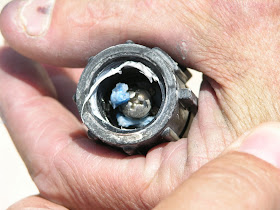 |
| Pvc glue plugging an irrigation bubbler after a repair |
Q. A few years ago I had a bubbler system installed to water my trees for my desert landscaping. They did not do a good great job. It has gotten plugged a few times and the trees do not get enough water. I have gone through four trees and maybe another. Would you give me some names of trees that are truly drought resistant?
A. I hesitate giving you suggestions on plants because that is a highly subjective decision and secondly without a reliable irrigation system nothing will work in our desert except maybe Joshua trees. Besides, in our desert there are no ornamental and shade trees that will survive or look good without a good irrigation system.
 |
| Y filter for drip irrigation |
 |
| Salt accumulation on a drip emitter |
Make sure your irrigation system has a 150 to 200 mesh filter installed somewhere before the water reaches the emitters. This will reduce plugging. Make sure that when you or anyone repairs a drip system that they DO NOT use a pipe cutting device that rips the piping. So do not use a hacksaw or other pipe cutter that uses teeth to rip at the pipe. This will leave pipe debris in the lines that will (guaranteed) plug your emitters.
 |
| PVC cutter that does not leave debris in the pipes |
Use only a cutting device that has an unserrated knife edge that cuts the piping. Use pipe cutters instead. They are more expensive but will actually work quite well. I don’t care how careful you think you are, don’t use devices that rip or shred on any part of a drip system. Once you have a reliable irrigation system then you can plant some good stuff.





